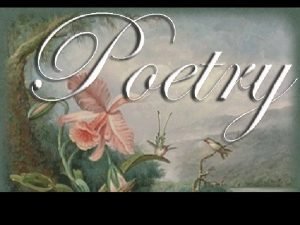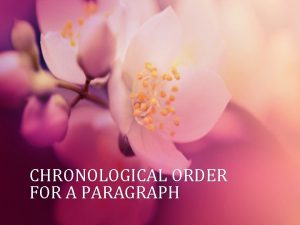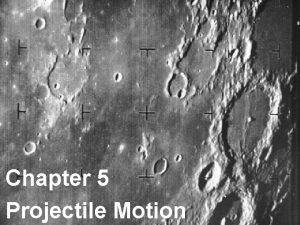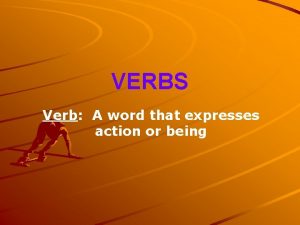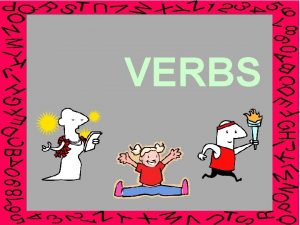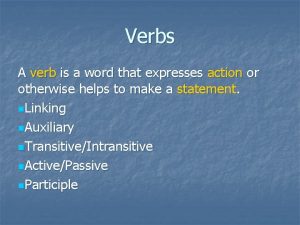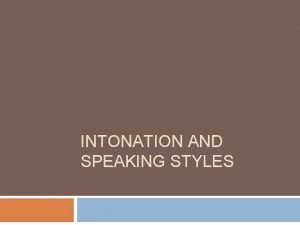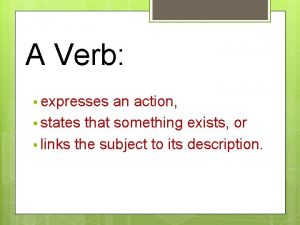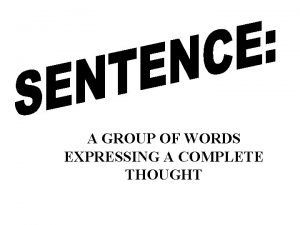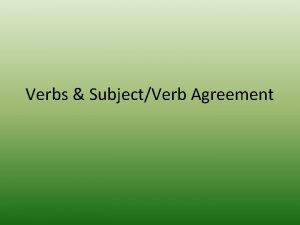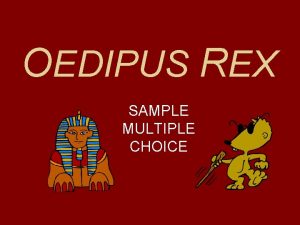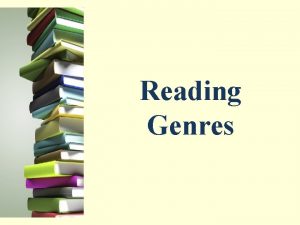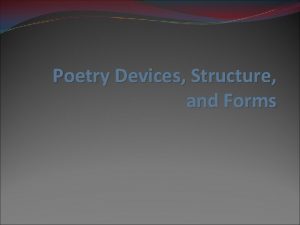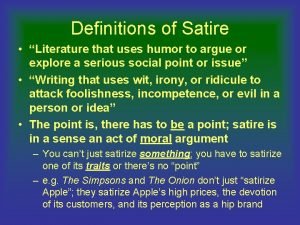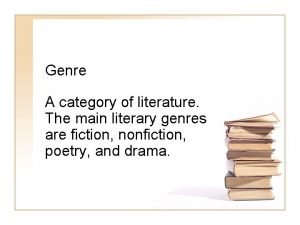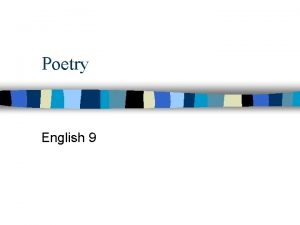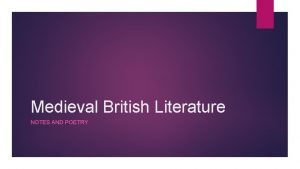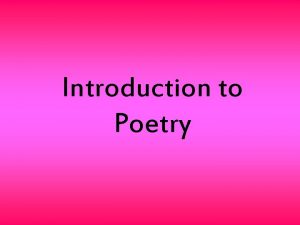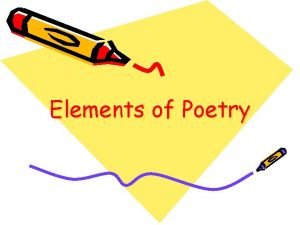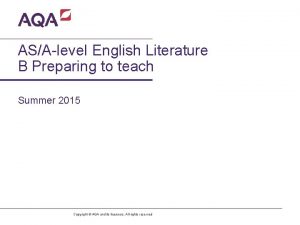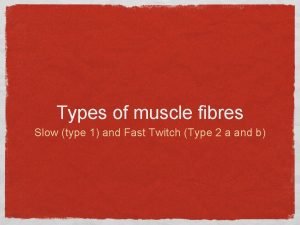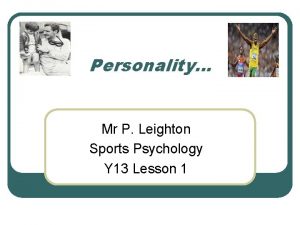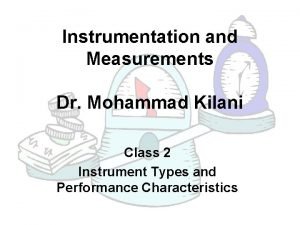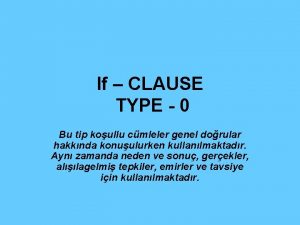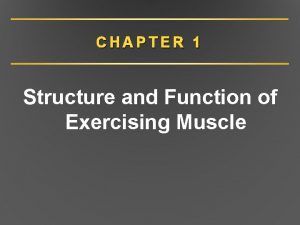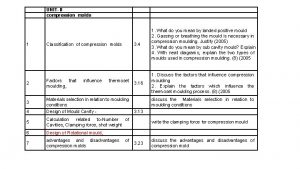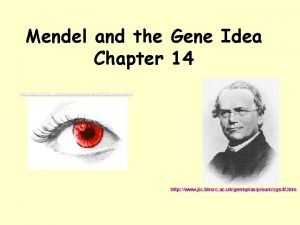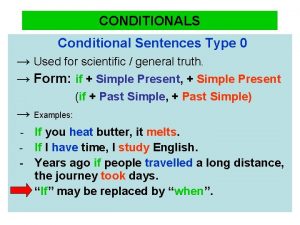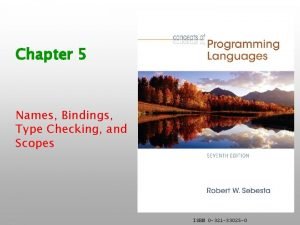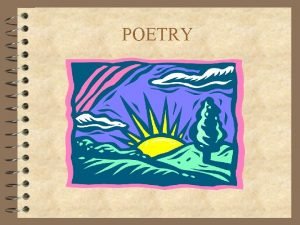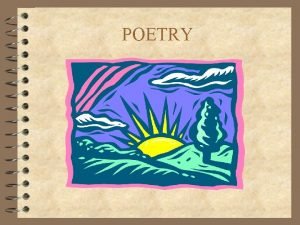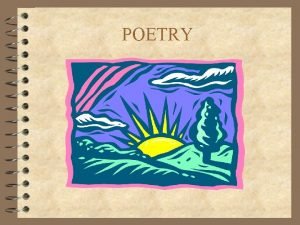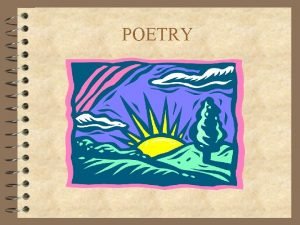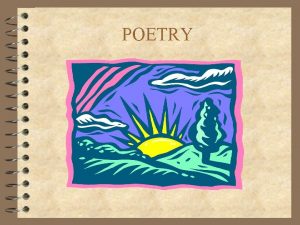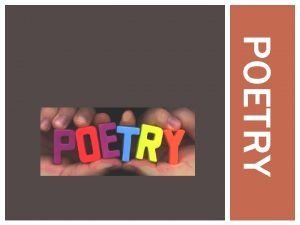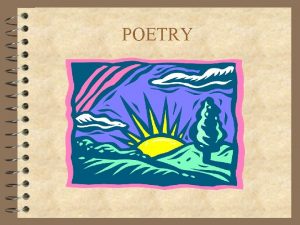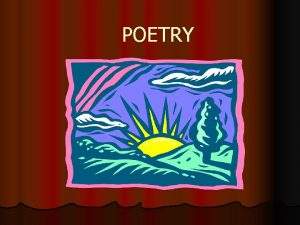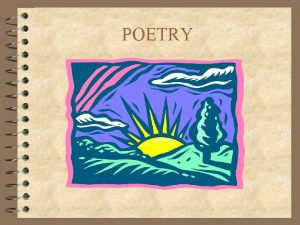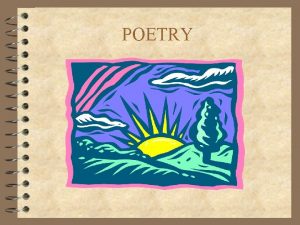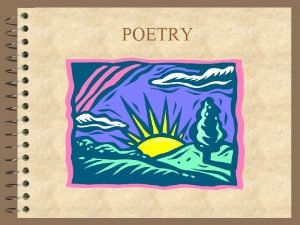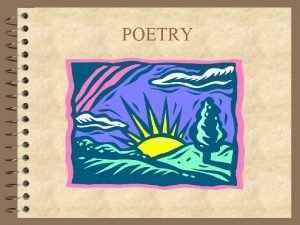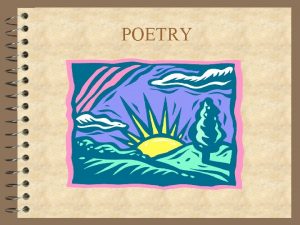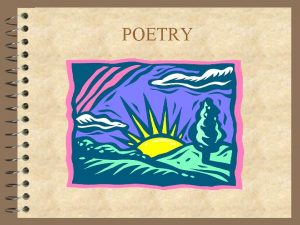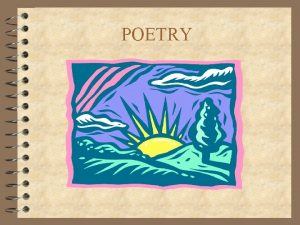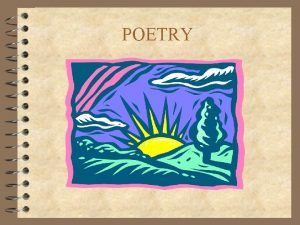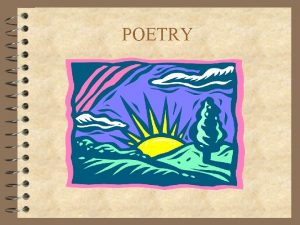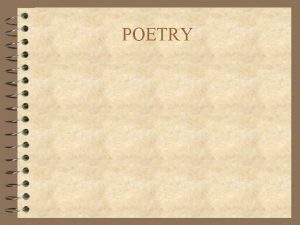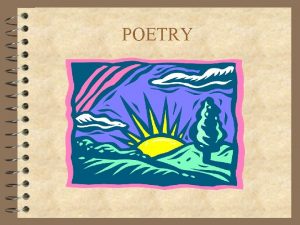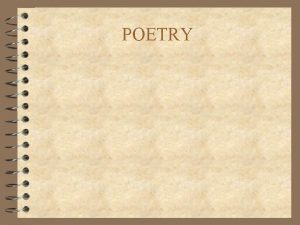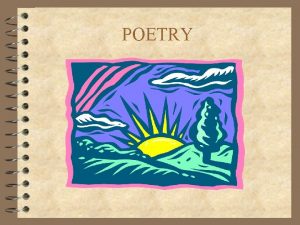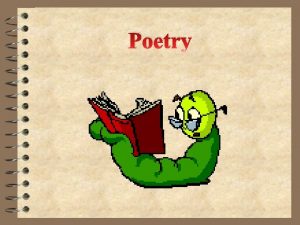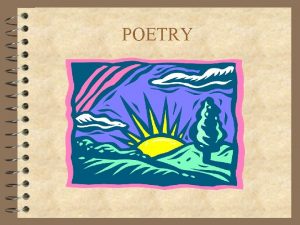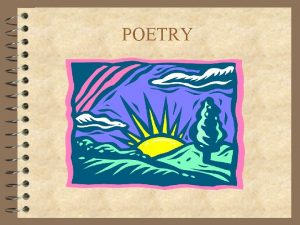POETRY POETRY A type of literature that expresses

























































- Slides: 57

POETRY

POETRY Ø A type of literature that expresses ideas, feelings, or tells a story in a specific form (usually using lines and stanzas)

POINT OF VIEW IN POETRY POET 4 The poet is the author of the poem. SPEAKER 4 The speaker of the poem is the “narrator” of the poem.

POETRY FORM 4 FORM - the appearance of the words on the page 4 LINE - a group of words together on one line of the poem 4 STANZA - a group of lines arranged together A word is dead When it is said, Some say. I say it just Begins to live That day.

KINDS OF STANZAS Couplet Triplet (Tercet) Quatrain Quintet Sestet (Sextet) Septet Octave = = = = a two line stanza a three line stanza a four line stanza a five line stanza a six line stanza a seven line stanza an eight line stanza

SOUND EFFECTS

RHYTHM 4 The beat created by the sounds of the words in a poem 4 Rhythm can be created by meter, rhyme, alliteration and refrain.

METER Ø A pattern of stressed and unstressed syllables. Ø Meter occurs when the stressed and unstressed syllables of the words in a poem are arranged in a repeating pattern. Ø When poets write in meter, they count out the number of stressed (strong) syllables and unstressed (weak) syllables for each line. They they repeat the pattern throughout the poem.

METER cont. 4 FOOT - unit of meter. 4 A foot can have two or three syllables. 4 Usually consists of one stressed and one or more unstressed syllables. 4 TYPES OF FEET The types of feet are determined by the arrangement of stressed and unstressed syllables. (cont. )

METER cont. Most famous type of meter: Iambic - unstressed, stressed

FREE VERSE POETRY 4 Unlike metered 4 Free verse poetry is poetry, free verse very conversational poetry does NOT have sounds like someone any repeating patterns talking with you. of stressed and unstressed syllables. 4 A more modern type 4 Does NOT have rhyme. of poetry.

BLANK VERSE POETRY from Julius Ceasar 4 Written in lines of iambic pentameter, but does NOT use end rhyme. Cowards die many times before their deaths; The valiant never taste of death but once. Of all the wonders that I yet have heard, It seems to me most strange that men should fear; Seeing that death, a necessary end, Will come when it will come.

RHYME 4 Words sound alike because they share the same ending vowel and consonant sounds. 4 (A word always rhymes with itself. ) LAMP STAMP á Share the short “a” vowel sound á Share the combined “mp” consonant sound

END RHYME 4 A word at the end of one line rhymes with a word at the end of another line Hector the Collector Collected bits of string. Collected dolls with broken heads And rusty bells that would not ring.

INTERNAL RHYME 4 A word inside a line rhymes with another word on the same line. Once upon a midnight dreary, while I pondered weak and weary. From “The Raven” by Edgar Allan Poe

NEAR RHYME 4 a. k. a imperfect rhyme, close rhyme 4 The words share EITHER the same vowel or consonant sound BUT NOT BOTH ROSE LOSE á Different vowel sounds (long “o” and “oo” sound) á Share the same consonant sound

RHYME SCHEME 4 A rhyme scheme is a pattern of rhyme (usually end rhyme, but not always). 4 Use the letters of the alphabet to represent sounds to be able to visually “see” the pattern. (See next slide for an example. )

SAMPLE RHYME SCHEME The Germ by Ogden Nash A mighty creature is the germ, Though smaller than the pachyderm. His customary dwelling place Is deep within the human race. His childish pride he often pleases By giving people strange diseases. Do you, my poppet, feel infirm? You probably contain a germ. a a b b c c a a

ONOMATOPOEIA 4 Words that imitate the sound they are naming BUZZ 4 OR sounds that imitate another sound “The silken, sad, uncertain, rustling of each purple curtain. . . ”

ALLITERATION 4 Consonant sounds repeated at the beginnings of words If Peter Piper picked a peck of pickled peppers, how many pickled peppers did Peter Piper pick?

REFRAIN 4 A sound, word, phrase or line repeated regularly in a poem. “Quoth the raven, ‘Nevermore. ’”

FIGURATIVE LANGUAGE

SIMILE 4 A comparison of two things using “like, as than, ” or “resembles. ” 4 “She is as beautiful as a sunrise. ”

METAPHOR 4 A direct comparison of two unlike things 4 “All the world’s a stage, and we are merely players. ” - William Shakespeare

EXTENDED METAPHOR 4 A metaphor that goes several lines or possible the entire length of a work.

IMPLIED METAPHOR 4 The comparison is hinted at but not clearly stated. 4 “The poison sacs of the town began to manufacture venom, and the town swelled and puffed with the pressure of it. ” - from The Pearl - by John Steinbeck

Hyperbole 4 Exaggeration often used for emphasis. They have yarns Of a skyscraper so tall They had to put hinges On the two top stories To let the moon go by - Yarns by Carl Sandburg

Litotes 4 Understatement - basically the opposite of hyperbole. Often it is ironic. 4 Ex. Calling a slow moving person “Speedy”

Idiom 4 An expression where the literal meaning of the words is not the meaning of the expression. It means something other than what it actually says. 4 Ex. It’s raining cats and dogs.

PERSONIFICATION 4 An animal given humanlike qualities or an object given life-like qualities. from “Ninki” by Shirley Jackson “Ninki was by this time irritated beyond belief by the general air of incompetence exhibited in the kitchen, and she went into the living room and got Shax, who is extraordinarily lazy and never catches his own chipmunks, but who is, at least, a cat, and preferable, Ninki saw clearly, to a man with a gun.

OTHER POETIC DEVICES

SYMBOLISM 4 When a person, place, thing, or event that has meaning in itself also represents, or stands for, something else. = Innocence = America = Peace

Allusion 4 Allusion comes from the verb “allude” which means “to refer to” 4 An allusion is a reference to something famous. A tunnel walled and overlaid With dazzling crystal: we had read Of rare Aladdin’s wondrous cave, And to our own his name we gave. From “Snowbound” John Greenleaf Whittier

IMAGERY 4 Language that appeals to the senses. 4 Most images are visual, but they can also appeal to the senses of sound, touch, taste, or smell. then with cracked hands that ached from labor in the weekday weather. . . from “Those Winter Sundays”

TPCASTT Poetry Analysis n! titio e p e r onom atopo 1/09 Poetry Unit: TP-CASTT - Blume eia! 35

TPCASTT is an ACRONYM for… Title Paraphrase Connotation Attitude Shift Title Theme It is a m e unders thod used to he tan commu d, appreciate lp us nicate , and a bout po and the e power of word try s. 36

First, let’s review some vocabulary: • literal = means “exact” or “not exaggerated”. Literal language is language that means exactly what is said. Most of the time, we use literal language. • figurative = the opposite of literal language. Figurative language is language that means more than what it says on the surface. Often used by poets and other writers. 37

Review vocabulary, continued: • denotation = the dictionary definition of a word or phrase • connotation = a meaning suggested by a word or phrase, in addition to its exact (denotative) meaning; can be the emotional feelings associated with the word Think of the denotative and connotative meanings of words such as home, mother, love, peace, friend, etc. 38

Write the following title and author on your TPCASTT handout Piano by D. H. Lawrence 39

Title: What predictions can you make about the poem from the title? What are your initial (first) thoughts about the poem? What might be theme of the poem? 40

Title: What predictions can you make from the title? The poem might be simply about a piano or playing a piano. Is it about some memory the author has or some special feelings he has about his piano? (now read the poem) 41

Piano by D. H. Lawrence. Softly, in the dusk, a woman is singing to me; Taking me back down the vista of years, till I see A child sitting under the piano, in the boom of the tingling strings And pressing the small, poised feet of a mother who smiles as she sings. In spite of myself, the insidious mastery of song Betrays me back, till the heart of me weeps to belong To the old Sunday evenings at home, with winter outside And hymns in the cozy parlour, the tinkling piano our guide. So now it is vain for the singer to burst into clamour With the great black piano appassionato. The glamour Of childish days is upon me, my manhood is cast Down in the flood of remembrance, I weep like a child for the past. 42

Title: What predictions can you make from the title? Read the poem. What are your initial (first) thoughts about the poem? What might be theme of the poem? 43

Title: What predictions can you It seems like the author is saddened by a make from the title? Read the childhood memory. Maybe theme is poem. What are your initial (first) thoughts about the poem? regret or nostalgia. What might be theme of the poem? 44

Paraphrase: Describe what happens in the poem, in your own words. 45

Paraphrase: Describe what happens in the poem, in your own words. The poet/speaker hears a woman singing, which makes him vividly recall a childhood memory. He listened to his mother playing the piano, while sitting underneath the piano and touching her feet. He longs to be back in the cozy, happy home of his family, when he was a child. He is overcome by emotion and cries. 46

Connotation: What might the poem mean beyond the literal level? Find examples of imagery, metaphors, similes, personification, symbolism, idioms, hyperbole, alliteration, rhyme scheme, rhythm, etc. and think about their possible connotative meanings. Consider the emotional feelings that the words may give the reader. 47

Connotation: What might the poem mean beyond the literal level? Find examples of imagery, metaphors, similes, personification, symbolism, idioms, hyperbole, alliteration, rhyme scheme, rhythm, etc. and think about their possible connotative meanings. Consider the emotional feelings that the words may give the reader. The poem might mean that the author/speaker is unhappy with his current adult life. Things seemed to be quite loving and warm in his childhood. There is a simple rhythm in the three-stanza, rhyming couplet structure, maybe related to his pleasant, more simple childhood. The piano itself is a symbol of rhythmic emotion. Rich imagery created by use of such devices as onomatopoeia (boom, tingling, tinkling) and simile (weep like a child). The word “appassionato” suggests heightened emotions (passion). “Manhood is cast down” suggests he is giving in to his longings for the past. 48

Attitude: Describe the tone of the poem. What is the poet’s attitude toward the subject of the poem? The speaker’s attitude? Find and list examples that illustrate the tone and mood of the poem (these show attitude). 49

The poet/speaker’s tone seems to be one of sadness and longing, as shown by “till the poem. What is the poet’s the heart of me weeps to belong…”, “the attitude toward the subject of glamour of childish days is upon me…”, the poem? The speaker’s attitude? Find and list examples and “I weep like a child for the past”. that illustrate the tone and mood of the poem (these show “softly, in the dusk…” attitude). “a mother who smiles as she sings…” “betrays me back, till the heart of me weeps to belong…” “cast down in a flood of remembrance…” Attitude: Describe the tone of 50

Shift: Is there a shift (a change) in the tone or speaker of the poem? Where does the shift happen in the poem? What does it shift from and to? 51

Shift: Is there a shift (a change) in There is a subtle shift in tone from the tone or speaker of the poem? Where does the shift happen in the poem? What does it shift from and to? beginning of the poem , which seems like a simple recollection of a childhood memory. In the second stanza, the author/speaker uses words like “betrays” and “weeps” to indicate a desire to return to these happier times. Then in the third stanza, words like “it is in vain”, “appassionato”, “manhood is cast down”, “flood of remembrance”, and “I weep like a child for the past” demonstrate a more painful longing to have things the way they used to be. 52

Title: Look at the title again. Have your original ideas about the poem changed? How? What do you think the title means now? 53

I think the title Piano represents a focal Have your original ideas about point for the author/speaker’s feelings. the poem changed? How? What Pianos and music are, by nature, connected with our emotions and often do you think the title means with other people in our lives. Music can now? prompt us to feel very deeply, and thus the piano comes to represent a much happier time in the life of the author/speaker. Title: Look at the title again. 54

Theme: What is the overall theme of the poem? What insight, understanding, lesson, or truth are we supposed to have after reading this poem? 55

Theme: What is the overall theme of the poem? What insight, understanding, lesson, or truth are we supposed to have after reading this poem? The theme of the poem appears to be longing for the past, which may seem to have been more loving and happy. 56

Doing a TPCASTT poem analysis will help you turn your observations into meaningful discussions or writing. You have noticed the details - now can put them together so you can understand talk about the poem much better. 57
 Block av độ 2
Block av độ 2 Ngoại tâm thu thất chùm đôi
Ngoại tâm thu thất chùm đôi Thể thơ truyền thống
Thể thơ truyền thống Thơ thất ngôn tứ tuyệt đường luật
Thơ thất ngôn tứ tuyệt đường luật Walmart thất bại ở nhật
Walmart thất bại ở nhật Tìm vết của đường thẳng
Tìm vết của đường thẳng Hãy nói thật ít để làm được nhiều
Hãy nói thật ít để làm được nhiều Tôn thất thuyết là ai
Tôn thất thuyết là ai Gây tê cơ vuông thắt lưng
Gây tê cơ vuông thắt lưng Sau thất bại ở hồ điển triệt
Sau thất bại ở hồ điển triệt Poem about julius caesar
Poem about julius caesar Chronological
Chronological Which cannonball strikes the ground first
Which cannonball strikes the ground first The menu expresses the concept and theme through
The menu expresses the concept and theme through Expresses action or being.
Expresses action or being. Expresses action
Expresses action A verb is a word that expresses
A verb is a word that expresses Language processing system in compiler design
Language processing system in compiler design Intonation examples sentences
Intonation examples sentences Which of these verbs expresses an action that is
Which of these verbs expresses an action that is It is a group of words that expresses a complete thought
It is a group of words that expresses a complete thought A verb expresses
A verb expresses Tenses exercises with answers
Tenses exercises with answers Compiler bridges the semantic gap between which domains?
Compiler bridges the semantic gap between which domains? Oedipus rex practice multiple choice questions answers
Oedipus rex practice multiple choice questions answers A category or type of literature
A category or type of literature Structural devices poetry
Structural devices poetry Definition of satire in literature
Definition of satire in literature A category or type of literature
A category or type of literature What is metered verse
What is metered verse British literature notes
British literature notes The literature compiled more of poetry as opposed to prose
The literature compiled more of poetry as opposed to prose What are element of poetry
What are element of poetry Sensory language definition
Sensory language definition Edexcel paper 1 english literature
Edexcel paper 1 english literature Social and political protest writing examples
Social and political protest writing examples Patricia pogson yesterday
Patricia pogson yesterday Is hyper v type 1 or type 2
Is hyper v type 1 or type 2 Aceytlcholine
Aceytlcholine Type 1 type 2 error power
Type 1 type 2 error power Type 2 vs type 1 error
Type 2 vs type 1 error Rock cycle
Rock cycle Type a and type b personality theory
Type a and type b personality theory Mbti percentages
Mbti percentages Myotonic dystrophy type 2 vs type 1
Myotonic dystrophy type 2 vs type 1 Null and deflection type instruments
Null and deflection type instruments Type 0 type 1
Type 0 type 1 Difference between type 1 and type 2 error
Difference between type 1 and type 2 error Type 1 error vs type 2 error example
Type 1 error vs type 2 error example Type checking in compiler design
Type checking in compiler design O blood type and b blood type offspring
O blood type and b blood type offspring Type 1 vs type 2 fibers
Type 1 vs type 2 fibers Type 2 hit
Type 2 hit Bulk factor in compression moulding
Bulk factor in compression moulding Blood type and body type
Blood type and body type Pot type mold & plunger type mold are the classification of
Pot type mold & plunger type mold are the classification of Type 0 and 1 conditionals
Type 0 and 1 conditionals Name type compatibility and structure type compatibility
Name type compatibility and structure type compatibility










